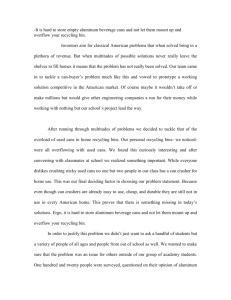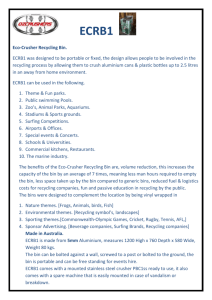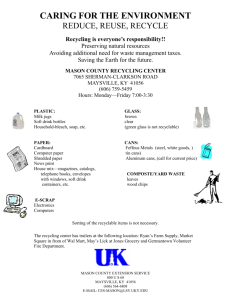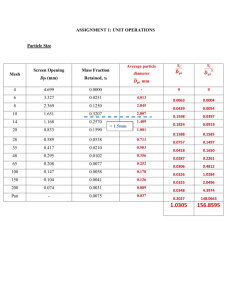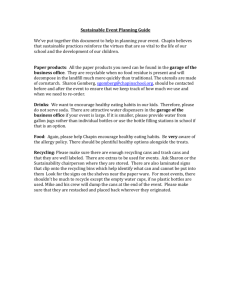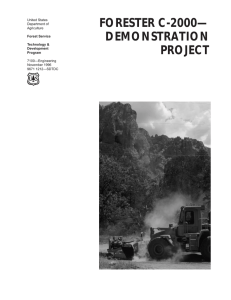Design Project Brief Can Crusher Mfg./Environmental Sector Project
advertisement
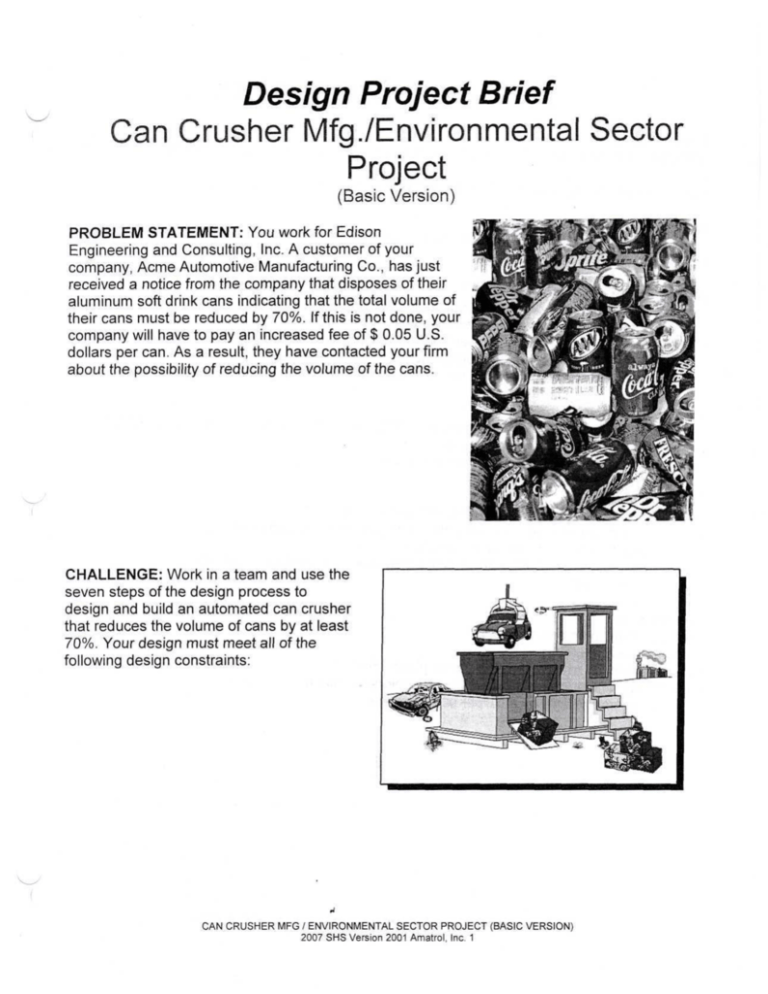
Design Project Brief Can Crusher Mfg./Environmental Sector Project (Basic Version) PROBLEM STATEMENT: You work for Edison Engineering and Consulting, Inc. A customer of your company, Acme Automotive Manufacturing Co., has just received a notice from the company that disposes of their aluminum soft drink cans indicating that the total volume of their cans must be reduced by 70%. If this is not done, your company will have to pay an increased fee of $ 0.05 U.S. dollars per can. As a result, they have contacted your firm about the possibility of reducing the volume of the cans. CHALLENGE: Work in a team and use the seven steps of the design process to design and build an automated can crusher that reduces the volume of cans by at least 70%. Your design must meet all of the following design constraints: CAN CRUSHER MFC / ENVIRONMENTAL SECTOR PROJECT (BASIC VERSION) 2007 SHS Version 2001 Amatrol, Inc. 1 Prototype Constraints Team's Tasks: Prototype Constraints: As a part of your challenge your can crusher design must: • use a pneumatic cylinder to crush the cans via a mechanism of some type. Electric relay control system that: • controls the pneumatic-powered can crushing operation. • crush cans to 70% of original size. Electrical power system that: • satisfies the electrical power requirements of the system. • provides circuit protection devices for the system. • provides a means of removing power from the system by pressing stop pushbutton. • have at least one component manufactured by a CMC machine. • have at least one component manufactured with a manual machine tool. Can ejection system that: • ejects cans using a mechanism. This mechanism can be powered and controlled by either pneumatics, electrical, or a combination • is triggered by the retract stroke of the can crusher. Robot that: • performs the loading of fresh cans into the can crusher. • interfaces with the electric relay control system (operates the can crusher) to signal the start and stop of the process. • uses a pushbutton to start the process of picking up a can and loading it into the can crusher. Structure that: • holds the can to be crushed in place. • mounts to a table-top. • is strong enough to withstand the forces placed on it. • has at least one precision-made part with a tolerance that can only be measured reliably by a caliper or micrometer. CAN CRUSHER MFG / ENVIRONMENTAL SECTOR PROJECT (BASIC VERSION) 2007 SHS Version 2001 Amatrol, Inc. 2 Design Constraints _ f ™-~| CFUSHEDCANS STORW56 WILL BE EJECTED BIN J,-"'IMTO8W CHWSWU.BS MtMUAUY LOADED INTO FEEDER FOR /ROBOT PICKUP ,' SENSOR ResourcQ Materials - You are initially supplied with pneumatic cylinders, limit switches, electrical relays, and other electrical fabrication and mechanical components from the 94-PK-MF1 Project Kit. Use these materials, the Internet, the lab stations, and any materials you can get from other sources to develop a solution to your project. If you find that you need other materials, create a Bill of Materials (BOM) and submit it to your instructor. You may also submit a request to your instructor to change one or more of the design constraints. This is done to allow you the greatest possible flexibility in your design. Dclivorables Your team is responsible for creating the following items as part of this project: Technology Sector Research Report (Individual) Working Prototype Design Portfolio Presentation and PowerPoint 100pts(seeStep2 pg 6) 100 pts (see pg 2) 100 pts (see pg 4 and Step 5 pg 8) 100 pts (see pg 4) CAN CRUSHER MFC / ENVIRONMENTAL SECTOR PROJECT (BASIC VERSION) 2007 SHS Version 2001 Amatrol, Inc. 3 Design Portfolio The Design Portfolio should be desktop published, professional in appearance, and contain the following items: Details are included in the 7-Step Design Process Guide. Technology Sector Research Report from each team member, each report consisting: • Operation and Application • History/Current Events • Impacts • Individual/ Organization Contribution Industry Market Research • Global Market Analysis • Industry Case Study Invention and Design Report consisting of the following • Problem Statement • Description of Research Collected • Sketches and descriptions of possible solutions • Explanation of process and reasons for choosing final design and description of how the chosen design works Developmental/Analysis work including: • Calculations with explanations • Schematics with explanation • Design Drawings • Programs • Bill of Material • Descriptions of problems encountered during design and any changes made as a result Description of Prototype Construction • How materials were obtained • How parts were made with photos of process • Problems encountered with design and any changes made as a result Testing and Evaluation • Description of testing process with photos • Problems encountered and how they were overcome • Results of testing • Analysis of Areas for improvement Presentation The Presentation and PowerPoint should be a summary of the Design Portfolio providing highlights of the three major sections of the portfolio. The presentation should be at 30-40 minutes long and include a lot of graphics and photos. Each team member should present for at least 5 minutes each. CAN CRUSHER MFC / ENVIRONMENTAL SECTOR PROJECT (BASIC VERSION) 2007 SHS Version 2001 Amatrol, Inc. 4 7-STEP DESIGN PROCESS GUIDE: Use the following steps as a guide to do your design project. STEP? Step 1: Problem Identification - State the above task in your own words. Step 2: Research and Investigation - Perform the following steps to research information about your project. You will research waste recycling programs and how they relate to the manufacturing technology sector and the environment. You will research the technical details needed to design and build your automated can crusher. Both the written report and your can crusher design research are to be included in your team's design portfolio. CAN CRUSHER MFG / ENVIRONMENTAL SECTOR PROJECT (BASIC VERSION) 2007 SHS Version 2001 Amatrol, Inc. 5 TECHNOLOGY SECTOR RESEARCH REPORT: Individual Assignment Develop a written 2-3 page report about manufacturers' waste reduction and recycling, Include the following information: • Operation and Application (At least 3 paragraphs, approx. 4-5 sentences per paragraph) • What is waste reduction? • What is recycling? • How is waste reduction & recycling accomplished? • When or why is waste reduction used? • When or why is recycling used? • What kinds of materials are recycled in the manufacturing industry? • Explain the operation of waste reduction machines. • History / Current Events (At least 3 paragraphs, approx. 4-5 sentences per paragraph) «What is the history of waste reduction in machine design and application? • What are some of the most recent waste reduction machine developments? • Site a published article of a recent event concerning waste reduction in manufacturing list the title, author, date, and publisher. • Impacts (At least 3 paragraphs approx. 4-5 sentences per paragraph) • What are the social impacts of waste reduction and recycling? • What are the economic impacts of waste reduction and recycling? • How has recycling impacted the manufacturing technology sector? • What are the ecological and environmental impacts of waste reduction and recycling? • What is the ultimate goal of waste reduction and recycling programs? • Individual/Organization Contribution (At least 3 paragraphs approx. 4-5 sentences per paragraph) • Who: Individual/Organization who has made a significant contribution to the recycling field? • What: Biographical information (date of birth, family background, education, etc.) • When: Year(s) idea, product, or process was first used. • Where: Location of work (this should include the country, state, and city) • Why: Reasons for developing the idea, product, or process. • How: Describe working conditions and obstacles that had to be overcome. • Money: Did the individual or organization profit from the ideas? • Impact: What other events occurred as a result? • Anecdote: Find an unusual or humorous story about your topic. Type 3 Writing:http://thewritingsite.org/resources/approaches/collins/default.asp F.C.A. "focus correction areas" Logical & interesting sequence. Use proper grammar, spelling & punctuation. Grading Rubric See: http://www.geocities.com/shstechteacherAA/rittenReportRubrics.htm Content 5 pts Creativity Organization Mechanics Bibliography Length of Report Total 5 pts 5 pts 5 pts 5 pts 5 pts 30 pts x 3.33 weighted = 99.9 points w CAN CRUSHER MFG / ENVIRONMENTAL SECTOR PROJECT (BASIC VERSION) 2007 SHS Version 2001 Amatrol, Inc. 6 CAN CRUSHER DESIGN RESEARCH - Your task is to gather all of the information needed for you to develop some ideas about a can crusher design. Research to find ideas about the can crusher portion of the challenge facing you. Your given text, the Internet, Usenet News, Integrated Learning Units, and the library may be the best sources. Your instructor will also have a list of resources that may help you. You may start by studying the cans themselves. For example, you can use the graph below to determine the amount of force your can crusher needs to generate to crush a can. 1 00%. -i DENTED CANS UNDENTED CANS 60% 1 O •z 30';, eo% 25 50 75 100 125 150 175 ZOO FORCE APPLIED (Ibs) Some information you may want to determine in order to accomplish your project: - What are the initial dimensions of the can? • How big must the can crusher be in order to accept a new can? • How much must the can be crushed to achieve a 70% reduction in volume? - How much force must be applied to the can to crush it by 70%? • What power sources are available that can deliver this force? - Would denting the can help in crushing it? Much of the research collected in this step relates to general design. All team members should participate in this research. The design details of the components, such as a control system, should only be researched to a point where the team can conceive of possible solutions in step 3 and select a design idea to carry forward in step 4. However, additional solutions may be conceived by team members as they spend time in their subject matter expert (SME) cluster. Step 3: Create Possible Solutions - Use the knowledge gained from Step 2 to develop twelve or more possible design solutions. Each team member should supply at least two solution. Make a rough sketch of each along with a brief description of how it works. Save each of the sketches and include them in the team portfolio. The design ideas should be detailed only enough to compare them. The detailed design will take place in Step 5. Step 4: Choose the Best Solutions - Choose the solution that best meets the design specifications. Document your reasons for choosing this particular solution in your team portfolio. Step 5: Analysis/Developmental Work - In this step, you will perform the developmental work needed to create yotir design. To complete this work, team members CAN CRUSHER MFG / ENVIRONMENTAL SECTOR PROJECT (BASIC VERSION) 2007 SHS Version 2001 Amatrol, Inc. 7 will need knowledge and skills from the lab stations in their SME clusters. This developmental work should include the following: Calculations - Perform all calculations on separate sheets of paper. At the top of each sheet, describe what calculation is being performed and why it is needed. Make sure all of the steps are neat and organized. Schematics - Create schematics for the electric and pneumatic systems. Although it may help to first sketch them by hand, electrical schematics are to be created using CAD. Pneumatic schematics are to be created using the pneumatic simulation software. Programs - At least one of the parts in your design will be manufactured using a CMC machine. Make a printout of the part program created in this operation. You will also need to make a printout of the program used to control the robot in its operation. Bill of Materials - Make a bill of materials for the construction of the prototype. If equipment is needed in addition to the equipment provided in the 96-PK-MF1, calculate additional costs of the equipment. For additional equipment, make a statement on how the increased cost of the added equipment will benefit the outcome of the project. Submit the statement and the BOM to your instructor so that additional material, if needed, can be ordered. Drawings - Use CAD to make detailed individual part drawings and an assembly drawing of the prototype. Make sure that you include part drawings of the parts to be made by CMC machines and manual machines. Include dimensions and assembly notes where applicable. Create Portfolio with reports specified. Step 6: Construct a Prototype - Construct a prototype using your design drawings. Make notes when or where the prototype varies from the design drawings. Create digital photographs of the prototype and the team members as they create the prototype. Include them in your team portfolio. Step 7; Testing and Evaluation - Once assembled and the applicable power supplies are applied, test the operation of the can crusher. Make sure the can crusher is self-loading and self-unloading. Feed the design fresh, uncrushed cans. Measure the dimensions of a crushed can and calculate its volume. Compare the volume of a crushed can to that of an uncrushed can to determine the degree to which the can has been crushed. Test the crusher several times and make adjustments as necessary to increase the amount that each can is crushed. Continuous Improvement Analysis - Based on your testing and evaluation, identify areas in which your design met and exceeded the design specifications. Next, identify areas in which your design fell short of the design specifications. Finally, describe how you might improve your design in the future. w CAN CRUSHER MFG / ENVIRONMENTAL SECTOR PROJECT (BASIC VERSION) 2007 SHS Version 2001 Amatrol, Inc. 8

